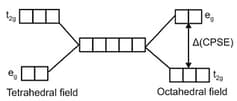Crystal Field Theory
Crystal Field Theory: Overview
This topic covers concepts, such as Crystal Field Splitting Theory, Spectrochemical Series, Crystal Field Splitting in Octahedral Complexes, Crystal Field Splitting in Square Planar Complexes, Crystal Field Splitting in Tetrahedral Complexes, etc.
Important Questions on Crystal Field Theory
: [Ti(H2O)6]4+ is coloured while [Sc(H2O)6]3+ is colourless.
: d - d transition is not possible in [Sc(H2O)6]3+
The correct order for the wavelengths of absorption in the visible region for the following is:
The value of the spin only magnetic moment for one of the following configurations is BM. The correct one is
Which of the following configuration of ions has zero CFSE in both strong and weak ligand fields ?
Which of the following statement is correct ? (CFSE = Crystal Field Splitting Energy)
The correct relation about the value of for the following complexes.
The configuration of central atom is for octahedral complex. The correct statement about this compound.
The octahedral complex of a metal ion with four monodentate ligands absorb wavelengths in the region of red, green, yellow and blue, respectively. The increasing order of ligand strength of the four ligands is
In which of the following complexes, magnetic moment will change when all the ligands are replaced by ion to form a cyano complex?
Which of the following compounds is not coloured?
An octahedral complex with magnetic moment may have:
(a) configuration with weak field ligand.
(b) configuration with strong field ligand.
(c) configuration with strong field ligand.
(d) configuration with weak field ligand.
Identify the correct set for :
Crystal field splitting energies for octahedral and tetrahedral geometries caused by the same ligands are related through the expression
Which one of the following complex has the highest magnitude of Crystal Field Splitting Energy ?
The electronic configuration of in as calculated using crystal field theory is
The order of octahedral crystal field energy for orbitals are
Which sets of the orbitals are directly oriented towards the ligands in the octahedral coordination compounds?
A transition metal complex adopts configuration. The nature of ligand surrounding the ion is :-
For next two question please follow the same
When degenerate -orbitals of an isolated atom/ion come under influence of magnetic field of ligands, the degeneracy is lost. The two set t2g (dxy, dyz,dxz) and eg (dz2, dx2-y2) are either stabilized or destabilized depending upon the nature of magnetic field. It can be expressed diagrammatically as :

Value of depends upon nature of ligand and a spectrochemical series has been made experimentally, for tetrahedral complexes, is about times to ( for octahedral complex). This energy lies in visible region and i.e., why electronic transition are responsible for colour. Such transitions are not possible with and configuration.
form four complexes with four different ligands which are [Cr(Cl)6]3-, [Cr(H2O)6]3+, [Cr(NH3)6]3+ and [Cr(CN)6]3-. The order of in these complexes is in the order :
